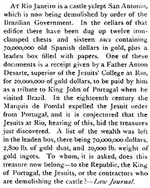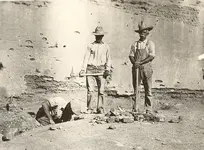Drifting Into the Weeds
Roy,
I have serious doubts about your "proof". As you know, that's nothing new. On the other hand, I respect your opinion. Here is what NPS has to say, for those who may not know:
Tumacacori's Yesterdays (The Treasure of Tumacacori)
Good luck,
Joe
Joe - I did
not point to Tumacacori but
San Xavier del Bac; do you contend that
the mission of Bac, did not have a massive amount of silver, which is not there to be seen today? Thanks in advance, and by the way, you are aware that the NPS has held the polar opposite "opinion" about Tumacacori, treasure and Jesuit mining until fairly recently right? Do you agree, that in most history subjects, the closer you get to the actual events, the more accurate your sources are likely to be?
At the risk of heading FAR off into the weeds, I can back up my assertion that the treasures of San Xavier del Bac were hidden by the Indians who lived there, brought out for the return of the Jesuits, and today are LOST. Quote
In 1863 thirty five years after its abandonment it was again taken possession of by two members of the order who founded it. These priests were from Los Angeles California and accompanied the first Commissioner of Indian Affairs, Mr Poston when he visited the Territory. Great was the joy of the simple Papagos at having the black gowns once more among them. The gold and silver vessels of the altar and all the other valuable ornaments were brought forth from the secure hiding places where they had remained undisturbed all these long vears nave chancel and altar were gay-ly decorated lights flashed from every column and the voices of the happy Papagos filled the dim aisles and lofty arches of the old church with songs of joy and gladness. Since then religious services are held regularly and a school has been established by the Sisters of St Joseph but the pastor resides in Tucson and the edifice is left entirely in charge of the Indians who take the greatest of it
The resources of Arizona, Patrick Hamilton, pp 378
There are other sources which confirm this, but further, the Vekol mine is another example of a long-lost mine, known to the Indians whom had been forced to work it, shown to their friend Dr. John Walker.
Do you deny that the Vekol mine exists? Do we have any reason NOT to believe that it was shown to Dr Walker by his friend the Indians?
Really Joe your standards and/or sources for "proof" are rather questionable to my view; the Park Service whom you point to as proof, has changed its tune from one polar opposite to the other, the great historian father Polzer, was himself a Jesuit, and when has any Jesuit ever admitted to any kind of wrong-doing? This should really raise red flags for you, as it does for me, when the great majority of OLD historical sources are at odds with what is today claimed about this topic. We have discussed this in depth, at length, (some might say ad nauseum) and can point to sources like the Congressional Record, the National Geographic Society, and even the Jesuits themselves in some cases. The National Park Service has a vested interest in denying any truth to the Tumacacori mission treasure, as they do NOT wish to see the old ruins destroyed by careless treasure hunters. A good reason for sure, and I seriously doubt that any such treasure would have been concealed AT the mission itself anyway.
Sorry, getting carried away there, but seriously Joe, do you expect that the Jesuits of today, and the Park service, are going to publish complete admissions that there were huge amounts of precious metals being mined by the early missionaries, and a great deal of the metals were never shipped but concealed, that the Jesuits were using forced labor of the Indians to not only work in the mines but farming, herding cattle, building, making charcoal and lime etc? Do you really think that will ever happen?
My apologies to the thread owner for drifting so far off topic, just to prove a point.
Please do continue, I will not push this matter further as I do not expect to change Joe's mind on anything.

Oroblanco












